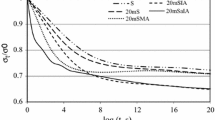Abstract
This paper describes a single-step, quantitative method for hydroxylation of unsaturated rubbers like EPDM. The resultant polyhydroxy elastomer was vulcanised using a diisocyanate under relatively milder conditions. The vulcanised product showed increased modulus in contrast to the sulfur- or peroxide-crosslinked systems. The enhanced cohesion originates from the urethane linkages which can be controlled either by regulating the concentration of the oxidant during hydroxylation or through the isocyanate –to- hydroxyl ratio (NCO/OH) during vulcanisation. This is the first ever report on the mid chain hydroxylation of unsaturated polymers and their polyurethane networks.

The unsaturation in EPDM rubber was hydroxylated by aqueous potassium permanganate and subsequently reacted with a diisocyanate to derive polyurethane network with enhanced cohesion.




Similar content being viewed by others
References
Abitha V.K,. Rane A.V, (2014) A review on EPDM / polyolefinic blends and composites, Research & Reviews in Polymers, 5(3), [102–114]
United States patent 3,042,661(1959) Isidor K, Muessig C W, Ralph M, Hill R M, Novel process for introducing functionality into high molecular weight polymers by oxidation with molecular oxygen in the presence of a boric acid compound
Justine G., Athul S., Reghunadhan Nair C.P., (2018), Indian Patent Application No. 201841002976; A process for obtaining polyols from rubber seed oil by a one-step hydroxylation, cross-linkable polymer products derived thereof and methods of preparing them
Panel EFJ, Mevis DMEAH (1972) Sensitized photo-oxidation of en-containing EPDM rubber. Eur Polym J (12):1375–1379
Nikje MMA, Motahari S, Haghshenas M, Sanami RK (2006) Epoxidation of ethylene diene monomer (EPDM) rubber by using in-situ generated dimethyl dioxirane (dmd propylene) and MOO3. J Macromol Sci A, pure and applied chemistry 43(8):2–3
Vadivel M, Kumar MSC, Raja JD, Ganesh MS, Narayan SA (2015) Thermal and morphology studies of siliconized epoxidized ethylene-propylene-diene terpolymer. Int. J. Chem. Sci. 13(2):737–746
Jiang ZWB (1997) In situ epoxidation of ethylene propylene diene monomer rubber by performic acid. Polymer 38:5407–5410
Yang P, Yang W (2014) Hydroxylation of organic polymer surface: method and applicationACS. Appl Mater Interfaces 6:3759–3770
Author information
Authors and Affiliations
Corresponding author
Additional information
Publisher’s note
Springer Nature remains neutral with regard to jurisdictional claims in published maps and institutional affiliations.
Rights and permissions
About this article
Cite this article
Nair, C.P.R., Shukla, S. Hydroxylation of EPDM as a means for ambient temperature vulcanisation via urethane chemistry. J Polym Res 26, 84 (2019). https://doi.org/10.1007/s10965-019-1743-3
Received:
Accepted:
Published:
DOI: https://doi.org/10.1007/s10965-019-1743-3




